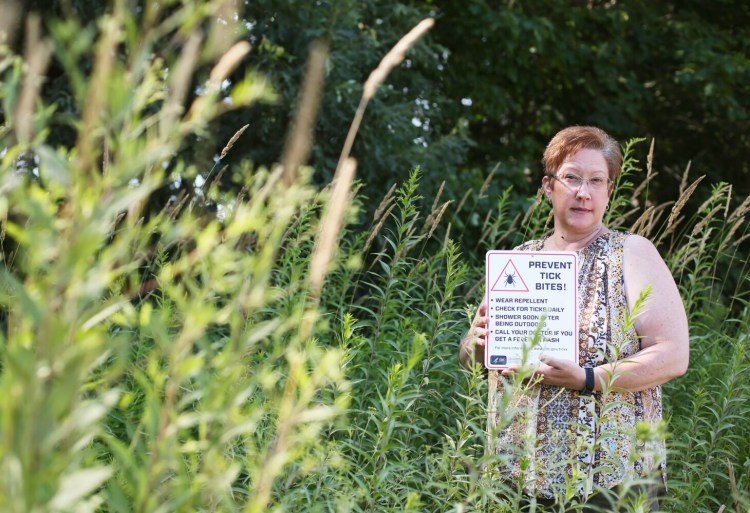Lyme disease cases are down significantly in 2019 compared to recent years, but scientists say the deer ticks that cause the illness are plentiful and Mainers should not expect the drop to signal a prolonged reprieve from the public health menace.
Though experts aren’t sure what led to the decrease in cases so far this year, they expect a resurgence in Lyme cases later this summer and into the fall.
Maine had 282 reported Lyme cases through July 28, down from 443 cases through July 2018, a 36 percent decrease, according to the Maine Center for Disease Control and Prevention. There were 543 Lyme cases during the same January-July period in 2017; 469 in 2016; and 534 in 2015.
Lyme disease causes flu-like symptoms, joint pain, swelling and neurological problems such as Bell’s palsy. Some people get a bull’s-eye rash where they were bitten by a tick. If discovered early, Lyme can be treated with antibiotics, but if left untreated it can cause long-term health problems, especially in the joints and nervous system, according to the U.S. Centers for Disease Control and Prevention.
Since 2013, Maine has experienced 1,200 or more Lyme cases per year, peaking at 1,852 in 2017. More than half of the Lyme cases are typically reported in late summer through October.
Chuck Lubelczyk, field biologist with the Maine Medical Center Research Institute, said field surveys reveal that deer ticks are abundant this year, as the rainy spring provided prime conditions for ticks to thrive. Ticks survive well in moist, damp conditions, and go into a hibernation-like state or perish in extremely dry conditions.
“We are seeing a robust amount of ticks in the field this year, and we are seeing them farther inland,” said Lubelczyk, explaining that ticks are traditionally more plentiful along the coast because of the humid, wet conditions in coastal Maine. “The ticks were very well hydrated. I would expect that with greater exposure to ticks, there will be greater risk for humans moving forward.”
Lubelczyk said compared to 2018 – when it was relatively dry – forest soils this July are moist, which is near-perfect conditions for ticks. Last year, the forest soils were “powder dry,” Lubelczyk said. An arid summer in 2018 may have led to somewhat reduced Lyme numbers, with 1,370 cases for the year, nearly 500 fewer than in 2017.

As for why Lyme cases are low so far in 2019, Lubelczyk said there could be a number of factors in play. One possible explanation is there may be a lag in reporting and confirming cases at the Maine CDC.
Also, the wet and cold spring may have contributed to less human-tick contact in the spring, he said.
“It’s possible that because it was cooler, people were wearing long sleeves and long pants longer into the year, at times when people are normally wearing T-shirts and shorts,” Lubelczyk said.
While Lyme cases are down so far, that’s not true of another tick-borne disease, anaplasmosis, which is tracking at similar rates to the past two years, with 362 cases through July 29, according to the Maine CDC. Lubelczyk said he doesn’t know why anaplasmosis numbers would be similar to last year while Lyme cases are down.
Deer ticks have increased their range in Maine over the past 20 to 30 years – a possible effect of climate change – and are now found in all 16 counties.
Nationally, the U.S. CDC reported 42,743 confirmed cases of Lyme in 2017 – the most recent year available for national statistics – a 17 percent increase compared with 2016.
Paula Jackson Jones of Nobleboro, an advocate for Lyme prevention and treatment, said that her “phone is ringing off the hook” with people reporting tick bites and asking her advice on what to do.
“I’m seeing ticks everywhere,” said Jackson Jones of the Midcoast Lyme Disease Support and Education nonprofit. “I’m seeing them at ballparks and in the playgrounds.”
Jackson Jones, who serves on a state vector-borne disease task force, said she has gotten a lot more requests for U.S. CDC tick prevention signs, which she hands out for free and can be posted in public places, such as at trailheads.
To protect against Lyme, wear repellent; perform tick checks; wear long-sleeved, light-colored clothing when out in the woods; and wear gloves when raking leaves or carrying firewood. Also, property owners should remove invasive plants, such as the Japanese barberry and bittersweet, which are prime tick habitats.
Sen. Susan Collins, R-Maine, introduced a bill this spring that would devote $100 million for fighting ticks and Lyme disease over a five-year period. The Ticks: Identify, Control and Knockout Act would dole out $20 million annually in grants to state health departments to collect and analyze data, support early detection and diagnosis, improve treatment and raise awareness.
Send questions/comments to the editors.




Success. Please wait for the page to reload. If the page does not reload within 5 seconds, please refresh the page.
Enter your email and password to access comments.
Hi, to comment on stories you must . This profile is in addition to your subscription and website login.
Already have a commenting profile? .
Invalid username/password.
Please check your email to confirm and complete your registration.
Only subscribers are eligible to post comments. Please subscribe or login first for digital access. Here’s why.
Use the form below to reset your password. When you've submitted your account email, we will send an email with a reset code.